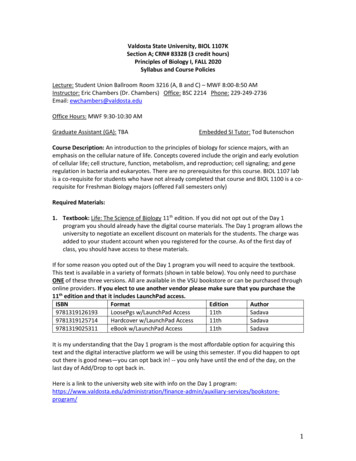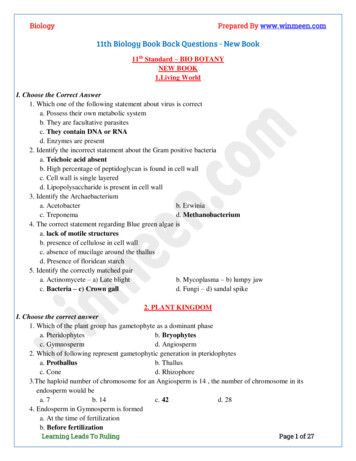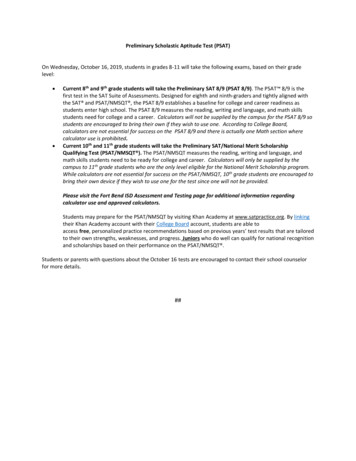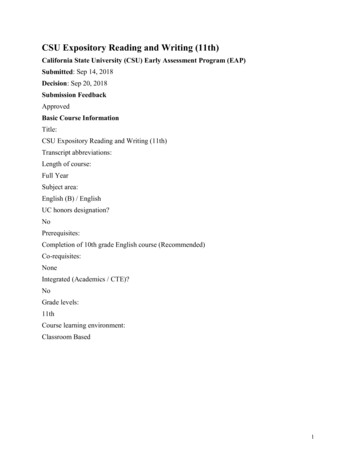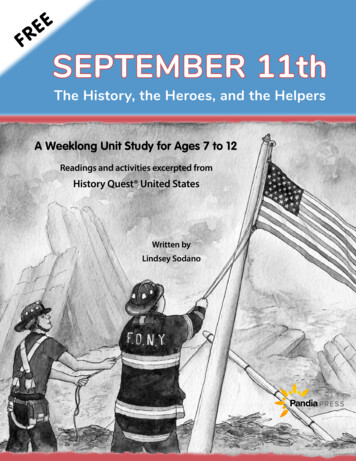
Transcription
SEPTEMBER 11th11thThe History, the Heroes, and the HelpersA Weeklong Unit Study for Ages 7 to 12Readings and activities excerpted fromHistory Quest United StatesWritten byLindsey Sodano
2021 Pandia PressAll rights reserved. No part of this work may be reproduced or used in any form by any means—graphic, electronic, ormechanical including photocopying, recording, taping, or information storage and retrieval systems—without writtenpermission from the publisher.* Printing note: The pages of this unit study may be printed by parents and teachers for family and classroom use.For best results, print on a duplex printer with “Print on both sides of the paper ” selected.September 11th – The History, the Heroes, and the Helpers written by Lindsey SodanoIllustrated by Candace RardonEdited by Carrie LoftyHistory Quest is a trademark of Pandia Press, Inc.Mount Dora, FLwww.pandiapress.com
September 11th Free Unit StudyTable of ContentsIntroduction . 5The History Quest Series . 6Supplies and Suggested Reading . 7Schedule . 8Terms & Concepts . 8September 11th chapter . 15History Hop! The Neighbor . 239/11 Flag-Raising coloring page . 31Mister Rogers coloring page . 33History’s Helpers worksheet . 35
September 11th Free Unit StudyIntroductionIn early 2020, parents around the world found themselves in the uncomfortable and even scary position ofhaving to explain a global pandemic to their children. At Pandia Press, we decided to do our part to helpduring that difficult time by releasing a free unit study called “Pandemic: Causes, Cures, Responses.” Wesincerely hope that the science and history resources in the unit helped parents help their children makesense of what was going on in the world.This year, we are once again approaching a time when some parents may find themselves at a loss forwords when it comes to helping their children understand another scary event. September 11, 2021, willmark the 20th anniversary of one of the most devastating events in United States history. To help youprepare for teaching this topic to young learners, we would like to offer our community the resources youwill find in this download.This unit study on the events of September 11, 2001, is an excerpt from the upcoming History Quest:United States chapter book and study guide, both written by Lindsey Sodano and published by PandiaPress. The History Quest series takes children on a journey to the past to experience the rise and fall ofcivilizations, empires, and cultures around the world. History Quest presents an immersive study of historyin an engaging and memorable format.Here are a few notes to help you get started: T he September 11th chapter excerpted from History Quest: United States is one of the later chaptersin the book. As such, it contains a few minor references to historical events that were presented inearlier chapters (e.g., it briefly mentions the invention of the incandescent light bulb). O ne of the assignments involves reading a History Hop. For those who aren’t familiar with the HistoryQuest format, each chapter includes a History Hop time-travel experience that transports the readerback in time to meet a real or imagined person from that era. The Suggested Reading booklist and the September 11th chapter itself are designed to be appropriatefor students ages 7 to 12, but we recommend pre-reading to make sure the material is suitable for yourchild’s specific situation. We had the opportunity to review a variety children’s books on this topic andwanted to include as many as possible, listed in order of relative appropriateness for sensitive readers.As always, we recommend checking your local library for books. If you have the ability to put librarybooks “on hold,” you may want to do so sooner rather than later, since these books will be especially indemand this year due to the 20th anniversary.We hope this unit study helps you approach the topic of September 11th with your child in an ageappropriate and reassuring manner.History Quest: United States and its accompanying study guide, both scheduled for release in 2022, cover UnitedStates history and civics. Please visit www.pandiapress.com for details and updates.-5-
History Quest: United StatesHistory Quest A complete elementary history curriculum that uses storytellingand hands-on activities to capture your child’s imagination.Journey into the long-ago past with History Quest: Early Times, the firstbook in the History Quest series. Experience the rise and fall of ancientcivilizations and visit faraway places to meet and learn from everydayfolks, famous world leaders, and even a few mythological characters!History Quest: Middle Times takes you on a journey through theMiddle Ages—a time of knights and ninjas, princesses and sultans, greatexplorations and technological advances, exciting cities and fascinatingfigures.History Quest: United States is coming in 2022. Visit pandiapress.comfor details and updates.History Quest Teacher’s LoungeIf you’re looking to connect with other families usingHistory Quest, please join our active, friendly FacebookGroup, History Quest Teacher’s Lounge. There you can findpro tips from parents, inspiration for extension projects,and helpful files such as crowdsourced lists of streamingservice documentaries to pair with History Quest.Meet the AuthorLindsey and family visiting the “Neighborhood”at the Children’s Museum of Pittsburgh in 2009.Lindsey Sodano is a writer, editor, and mom of three who lives inMason, Ohio. She has degrees in English and education from BostonCollege, where she focused her studies on children’s literature,feminist literary criticism, and alternative forms of education suchas homeschooling. After several years in the business world, Lindseybegan homeschooling her oldest child, JR, with a classically inspiredeclectic approach.Lindsey is the author of History Quest: Middle Times and study guide,as well as the editor and co-author of History Quest: Early Times. Sheis currently hard at work on History Quest: United States and study guide,scheduled for release in 2022.-6-
September 11th Free Unit StudyUNIT STUDYSEPTEMBER 11thThis Week’s QuestLearn about the events of September 11, 2001. Be sure to look for the helpers!Supplies September 11th chapter from Person to interviewHistory Quest: United States Recording device(attached) Scissors and glue Worksheets (attached)(optional) Drawing materialsSeven and a Half Tons of Steel by Janet NolanSaved by the Boats: The Heroic Sea Evacuationof September 11 by Julie GassmanAmerica Is Under Attack by Don BrownSeptember 11: Then and Now by Peter BenoitGround Zero Dogs by Meish GoldishSuggested Reading[Book titles link to Amazon. See pages 13–14 for detaileddescriptions of the following books including agerecommendations.]In Their Own Words: September 11, a PrimarySource History by Alan Wachtel14 Cows for America by Carmen Agra DeedyRanger in Time: Escape from the Twin Towers byKate MessnerFireboat: The Heroic Adventures of the John J. Harvey byMaira KalmanI Survived the Attacks of September 11, 2001 byLauren Tarshis-7-
History Quest: United StatesScheduleDay 1DiscoverDay 2ExploreDay 3CreateDay 4DemonstrateDay 5EnrichSeptember 11thchapterHistory Hop!The NeighborHistory’s HelpersworksheetReviewTerms & ConceptsExplore PandiaWeb LinksDiscoveronline videosColoring pagesExploring OralHistoryComplete oneor more reviewoptionsRead fromSuggestedReading listExploreGoogle EarthTerms & Concepts On September 11, 2001, hijackers took control of four airplanes in a terrorist attack. The Twin Towers of the World Trade Center in New York City were destroyed, as well as aportion of the Pentagon outside of Washington, D.C. Passengers aboard one of the planes banded together and heroically disrupted thehijackers. Their plane crashed in a field in Pennsylvania. Firefighters, police, paramedics, boat captains, and regular citizens rushed into action andmade brave sacrifices to save as many people as possible.-8-
September 11th Free Unit StudyLessonsDay 1. Discover Read September 11th from History Quest: United States Watch the September 11th video from BrainPopThis video is available all the time to BrainPop subscribers and is usually featured as the free dailyBrainPop video around September 11 each year. Alternatively, you might find the video by typing“BrainPop September 11th” in your search bar. American Jukebox: Listen to selections from America: A Tribute to HeroesJust ten days after the September 11 attacks, stars from music, TV, and film came together on livetelevision to raise money for the victims and their families, and especially for first responders inNew York City. That night, dozens of music artists performed, and Hollywood stars also contributedshort speeches. You can find many of the performances and speeches online, but note that they arenot all strictly secular, as some artists chose to invoke their faith in their performances.Visit Pandia's weblinks page for a link to one of the songs: Paul Simon sings “Bridge Over TroubledWater” during America: A Tribute to Heroes. www.pandiapress.com/weblinksDay 2. Explore Read History Hop! The Neighbor from History Quest: United States Coloring Pages. Color the 9/11 flag-raising illustration and/or the Mister Rogers illustration whilelistening to the History Hop. Google Earth. Search for “9/11 Memorial &Museum” on Google Earth to see what thesite looks like today.-9-
History Quest: United StatesDay 3. Create C omplete one or both of the following activities. Option 1 is best suited for younger students,and Option 2 is appropriate for upper elementary and older students. SuppliesOption 1: History’s HelpersOption 2: Exploring Oral History History’s Helpers worksheet Person to interview Pen or pencil Recording device (smartphone, tape recorder, etc.) Markers, crayons, or colored pencils Paper and pen/pencil, or a computer Scissors and glue (optional)DirectionsOption 1: History’s HelpersIn the History Hop, Khalid told you Fred Rogers had said that in scary times, we should “look forthe helpers.” This is your chance to learn more about one particular helper related to the attacks ofSeptember 11.Step 1: Thinking about what you’ve learned about9/11 so far, choose a helper you’d like to write about.It could be a famous person like Fred Rogers, whohelped parents understand how to talk to their youngchildren about the attacks. It could be an ordinary,everyday person like Todd Beamer, who took heroicaction to help save lives. It could even be one of theservice or search and rescue dogs that pitched in tohelp on September 11. It doesn’t have to be a specific,named person; instead you could study groups ofpeople such as the first responders who rushed intodanger or the boat captains who ferried citizens tosafety. The Suggested Reading booklist this weekcontains many examples of 9/11 helpers.ExampleStep 2: Use book(s) or the internet to learn moreabout the helper you chose. Fill out the History’sHelpers worksheet with what you’ve learned. Draw(or print out) a picture of your chosen helper andglue it to the sheet.- 10 -
September 11th Free Unit StudyOption 2: Exploring Oral HistoryOral history is when we study history using sound recordings of interviews with people who havedirect knowledge of an event from the past. Historians collect oral histories on all kinds of topics.Collecting many accounts of the same event can help us form a detailed picture of what happened.Chances are that you know someone who personally remembers September 11, 2001. Your job willbe to record an interview with this person. It does not have to be someone who was living in NewYork City, Washington, D.C., or Shanksville, PA, at the time. People living all over the world duringthat time still recall the day and have their stories to tell.Step 1: Find someone to interview. It could be a parent, grandparent, neighbor, or family friend—anyone who remembers where they were and what they were doing on September 11, 2001, andwho feels comfortable discussing their experience.Step 2: Write several interview questions. When collecting oral histories, the best questions areopen-ended questions, not closed-ended. Open-ended questions allow people to answer howeverthey choose. Closed-ended questions have a couple of specific answer choices such as “yes” or “no.”For example, asking someone “How did you feel?” allows the person to give you a longer, detailedanswer. If you ask a yes or no question like “Were you scared?” you will probably only get a briefanswer with fewer details.Here are a few sample questions you might consider asking:1. Where were you living on September 11, 2001?2. What were you doing or planning to do on the day of the attacks?3. How did you find out about the attacks taking place?4. Did you have to change your plans for the day (leave school, evacuate from a building, etc.)?5. Did you know anyone who was hurt in the attacks? What happened?6. How did your life change after September 11, 2001? Did the events of that day inspire you tomake any life changes?7. What’s the one thing you remember most from that time in history?Step 3: Interview your subject (the person you are interviewing) and record their responses. If youhave access to a tablet or smartphone, you probably have an app you can use to record voices. Ifnot, an old-fashioned tape recorder works great, too! Here’s a hint: Your subject should be doingmost of the talking. Your job is to ask probing questions and listen. You don’t have to stick strictlyto your question list, either. If you think of a good follow-up question during the interview, ask it!Be sure to thank your subject for their time when the interview is over.- 11 -
History Quest: United StatesStep 4: Listen to the recording of your interview. You may need to listen to it a few times. Finally, writea 1- to 2-paragraph summary of what you learned from your subject. If you want to, draw a pictureto go along with your summary. You may want to send a copy of your summary to your subject as athank-you gift.Day 4. Demonstrate R ead through the Terms & Concepts. Optional: Copy some or all of the Terms & Concepts into yourhistory notebook. Complete one or more of the following in order to strengthen your child’s knowledge of the materialand to provide an opportunity for you to evaluate their understanding. Option #1 Short AnswersAnswer the following questions verbally or write them in your history notebook:Q: Which building was the first to be hit on September 11, 2001?A: The North Tower of the World Trade Center was hit first.Q: When did most people start to realize that the first plane crash was not just an accident?A: They realized it wasn’t an accident when a second plane crashed, this time hitting the South Tower.Q: People on United Flight 93 called home and learned of the attacks. What did they do after that?A: They voted and decided to rush forward to try to disrupt the terrorists.Q: What was one reason why Fred Rogers decided to come back to television to talk to families on theanniversary of the attacks?A: He worried news stations would replay footage of the attacks and scare young children all over again.Option #2 NarrationAnswer the following verbally or in writing: List three important things you learned about September 11th.Option #3 Copywork/DictationCopy or write from dictation one of the following into your history notebook:- 12 -
September 11th Free Unit StudyFred Rogers said that when something scary happens,we should look for the helpers.The bridges, tunnels, and subways were closed. Captains steered theirtugboats and ferries to Manhattan to help transport people to safety.Day 5. Enrich Visit www.pandiapress.com/weblinks. There you will find a description of some recommendedwebsites related to this unit including a link to a brief clip from an episode of Mister Rogers’Neighborhood. In the clip, Fred Rogers shows children a behind-the-scenes look at his studio. R ead one or more from the Suggested Reading list. As always, please preview these booksahead of time for sensitive readers.Picture Books. The picture books are listed roughly in order from least intense to most intense interms of the imagery they depict and the topics they cover.14 Cows for America by Carmen Agra Deedy. This is the gentlest 9/11-themed picture book, and islikely appropriate for even the youngest readers. It doesn’t cover the attacks at all but rather thegenerous gesture the Maasai people made toward the United States after hearing of the attacks.Fireboat: The Heroic Adventures of the John J. Harvey by Maira Kalman. Colorful illustrations help tellthe story of the restoration of a 1930s fireboat. The John J. Harvey responded to the 9/11 attacksand helped pump water for firefighters. The focus of this book is more on the heroism of the crewand their historic boat rather than on scarier topics such as terrorism.Seven and a Half Tons of Steel by Janet Nolan. This beautifully illustrated book tells the story of asteel beam from the fallen World Trade Center that was remade into the bow of the Navy ship USSNew York. Note: Near the beginning of the book, there is one illustration of the first plane hittingthe North Tower.- 13 -
History Quest: United StatesSaved by the Boats: The Heroic Sea Evacuation of September 11 by Julie Gassman. This picturebook contains more information about the attacks, including illustrations of the Twin Towersfalling and frightened/injured people escaping from the city. The focus is on how all types ofboat operators responded to the scene to assist in the evacuation effort.America Is Under Attack by Don Brown. This well-researched book gives a detailed timeline ofthe events of September 11, including accounts from eyewitnesses. The illustrations are pencilsketches, but they include scenes of frightened, fleeing people; people trapped in the towers;and the towers falling. More suitable for older students.September 11: Then and Now by Peter Benoit. This book from the A True Book series retellsthe story of the attacks and their consequences, alongside lots of photos. This book does agood job of covering the aftermath of the attacks, such as the founding of the Departmentof Homeland Security, the War in Afghanistan, discrimination against Muslims, and the healthproblems first responders have experienced.Ground Zero Dogs by Meish Goldish. This book from the Dog Heroes series tells the stories ofseveral service dogs and search and rescue dogs involved in the rescue and recovery efforts of9/11. There are many photos of the wreckage and accounts of dogs locating bodies, so this isnot appropriate for more sensitive readers.In Their Own Words: September 11, a Primary Source History by Alan Wachtel. This book gives adetailed account of the events of September 11, including information on the background ofal-Qaeda and the aftermath of the attacks. The photographs are in full color, making this themost intense of the illustrated book options, suitable for middle grade students.Short NovelsRanger in Time: Escape from the Twin Towers by Kate Messner. This is a recent entry in the Rangerin Time series about a time-traveling golden retriever that rescues other characters fromdangerous historical situations. The book takes place at the World Trade Center, where Rangerassists two children to get out safely and reunite with separated family members. Notes: Noneof the main characters die or suffer serious injuries in the story, but Ranger does spend a shorttime in the rescue effort and helps the search team locate the remains of those who did notsurvive. The book does not cover the historical context or motivations of the terrorists, as itfocuses more on the evacuation effort at the World Trade Center.I Survived the Attacks of September 11, 2001 by Lauren Tarshis. Similar to the Ranger in Timebook, this short novel takes the reader right into Ground Zero on September 11. A young boyvisits his uncle’s fire station in Manhattan just before the attacks happen. Notes: None of themain characters die, though some are injured and a firefighter’s friend perishes in the attack.This book does not cover the background of the attacks.- 14 -
September 11th Free Unit StudyThe following reading is Chapter 24 in History Quest: United States.CHAPTER 24September 11th11 thTHE HISTORY OF the United States, like the history of anycountry, contains moments of joy and celebration as well asperiods of sorrow and grief. You’ve learned how amazed andexcited Americans were by inventions such as the incandescentlight bulb and medical breakthroughs such as the polio vaccine.The announcement of such discoveries makes us feel as ifanything is possible. You’ve also learned about many sad times,such as when legions of mourners came out to pay their respects- 15 -
History Quest: United Statesto President Abraham Lincoln as his body slowly returned hometo Illinois aboard The Lincoln Special. At times like those, thenation mourns. Today, it’s time to talk about another moment ofnational sorrow. Even though this is a story of pain and grief, it’salso a story of heroism and of citizens pulling together to supporteach other through a scary experience.September 11, 2001, started out like any normal Tuesday. Inthe eastern region of the United States, the weather was clearand beautiful. The cloudless sky was so vividly blue that it almostlooked like a child’s crayon drawing. People went about theirbusiness. Kids climbed into big yellow buses and headed offto school. Adults hit the highways or crammed onto crowdedsubway cars to get to work. People made small talk, just as theynormally do.It seemed like a completely pleasant, typical late-summer day.But at 8:46 a.m. Eastern Standard Time, our country changedforever. An airplane crashed into a 110-story skyscraper calledthe North Tower of the World Trade Center, a business complexin New York City. The building was just filling up with thousandsof people who were getting ready to start their workdays. Justafter the plane hit, nobody knew whether it was an accident oran attack. Of course, that didn’t matter at the time—those insidethe building were only trying to escape as safely and quickly aspossible. The building filled with smoke and debris, while peoplehelped each other find the open stairwells and start the longdescent to safety.As workers inside the building made their way down flightafter flight of stairs, firefighters lugging heavy rescue geartrudged up, up, up in the opposite direction. They headed straightinto the most dangerous areas. The firefighters who rushed to the- 16 -
September 11th Free Unit Studyscene knew it was useless to try to put out the flames. The massiveamount of jet fuel in the plane had exploded into a raging fire thatwould be nearly impossible to stop. For the firefighters, this was asearch-and-rescue mission to help free those who were trapped.Everyone in and around the North Tower felt confused andscared. Those who owned cell phones frantically dialed theirloved ones, trying to make sure they were safe. So many peoplestarted making calls at the same time that the circuits jammed up,which made it almost impossible to communicate by phone.Just 17 minutes after the first plane hit the World Trade Center’sNorth Tower, a second plane crashed into the South Tower. Justlike in the North Tower, those who survived the initial impactof the plane sprang into action. They assisted friends, coworkers,and perfect strangers in escaping the building. But one thing wasdifferent: Now that a second plane had hit, everyone realized thatthis was not an unfortunate accident. It was a terrorist attack.Terrorism is when someone uses violence to scare andintimidate people, usually civilians, in order to achieve a politicalgoal. The 19 men who carried out the attacks of September 11 weremembers of a terrorist organization called al-Qaeda [al-KYE-dah].A man named Osama bin Laden founded al-Qaeda about 20 yearsbefore the September 11 attacks. His goal was to scare the peopleof the United States so much that the U.S. would stop using itsmilitary power to support governments in the Middle East. Thatway, bin Laden and his organization would be able to take overmany of those Middle Eastern countries and force their citizensto follow an extreme form of the religion of Islam.One thing to remember is that the al-Qaeda terrorists did notrepresent the beliefs of most Muslims. Islam is a centuries-oldreligion that is peaceably practiced by its followers, who make up- 17 -
History Quest: United Statesalmost a quarter of the world’s population. Osama bin Laden wasnot a leader of Muslims or of the Islamic faith. He was just usingthe religion to achieve his terroristic goals.To carry out the attacks, bin Laden directed 19 of his followersto hijack, or forcefully take over, four airplanes and then purposelycrash them into important, crowded sites. Two planes departedfrom Boston, Massachusetts. One took off from Newark, NewJersey. The last took off from Washington Dulles InternationalAirport near Washington, D.C. Once the planes were in the air,the terrorists stormed the cockpits and wrested away control ofthe planes from the pilots.About a half hour after the attack on the South Tower in NewYork City, the third plane was crashed into the Pentagon. ThePentagon is a five-sided building complex near Washington, D.C.that serves as the headquarters of the U.S. military. The crashkilled many people and also started a large fire. Firefightershurried to the scene and immediately began battling the blaze.Some passengers on the fourth and final plane—United Flight93—were able to use onboard phones or cell phones to call lovedones at home. They learned about the other three hijackedplanes and feared that theirs was possibly heading toward animportant building full of innocent people. Even though theywere frightened and upset, the desperate passengers took themost democratic action possible: They voted on what to do next.As a group, they decided to rush to the front of the plane, stormthe cockpit, and try to take control away from the hijackers. Theyhad no time to lose.“Are you guys ready? Okay. Let’s roll!” said passenger ToddBeamer. The passengers charged forward to confront the terroristblocking the cockpit door. The hijackers inside the cockpit pitched- 18 -
September 11th Free Unit Studyand rolled the plane, trying to knock the passengers off-balance.Based on the recordings retrieved from the flight, we can’t be surewhether the band of heroic passengers made it inside the cockpit.What we do know for sure is that their quick thinking savedcountless lives. Their courageous action caused the hijackers tocrash the plane into an empty field in Pennsylvania instead of itsintended target, which many historians believe was either theU.S. Capitol or the White House.At around the same time that the brave passengers weremaking their plan to storm the cockpit of Flight 93, anothertragedy struck in New York City. The impact of the crash plus theheat of the burning jet fuel caused the South Tower of the WorldTrade Center to lose its stability. The building fell. Trapped officeworkers and the firefighters trying to rescue them perished in thecollapse. A cloud of debris blasted through the streets, knockingpedestrians to the ground and covering the city in smoke anddust. About a half hour later, stunned viewers around the worldwitnessed the North Tower collapse on live television. Now bothof the Twin Towers had fallen.The time between the hijacking of the first plane and thecollapse of the North Tower was just over two hours. Duringthe attacks, 2,977 people lost their lives. This number includedhundreds of fearless first responders who rushed to the TwinTowers to try to save their fellow citizens. Thousands more wereinjured. And millions more were shocked and scared.What did the grieving country do? How could Americans goon after such a tragedy? In New York City, people did everythingthey could to help each other. With bridges, tunnels, and subwaysclosed due to safety concerns, half a million people were strandedin Manhattan and needed a way out of the island city. Nearby- 19 -
History Quest: United Statesboat captains steered their tugboats and ferries at top speed toManhattan to help evacuate the frightened and injured citizens.All airplane flights in the United States were canceled, andthose in progress were told to land immediately. Internationalflights needed somewhere to land too. Many were diverted tosmaller airports outside the U.S. Several grounded flights leftthousands of passengers stranded in a tiny town in Canada calledGander for almost a week. Seeing the frightened, weary travelers,the residents of the town got to work. They opened their homesto total strangers and provided them with food, clothing, andhospitality until it was safe for them
Mason, Ohio. She has degrees in English and education from Boston College, where she focused her studies on children's literature, feminist literary criticism, and alternative forms of education such as homeschooling. After several years in the business world, Lindsey began homeschooling her oldest child, JR, with a classically inspired


